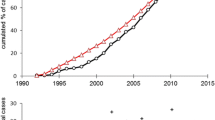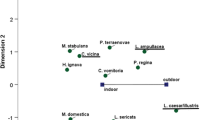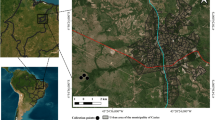Abstract
A carrion-related arthropod database is important for each locality especially temperate ecosystems. The present study aims to document baseline data about the decomposition process of indoor rat carrions and the diversity and succession pattern of the forensically important arthropods fauna that colonize these carrions. Twelve Sprague-Dawley rats were divided into four experimental rat models, killed by cervical dislocation, electric shock, drowning or slaughtering. The orders Diptera and Coleoptera were the main necrophagous arthropods that supported the decomposition process. Calliphoridae was the first insect family that colonized the carrions and lasted till the beginning of the dry decay stage. The succession pattern and the abundance of associated arthropods did not differ between control and drowning group. In the control and drowning groups, the insects of the order Diptera predominated the overall insect fauna (57.14%) followed by Coleoptera (42.85%), while their proportions were 50–50% in the electrocuted group. The slaughtered group showed 50, 42.85, and 7.14% for Diptera, Coleopteran, and Hymenoptera, respectively. This study submitted additional information in the context of forensic entomology, and provides a reference for the succession pattern and its influence on the decomposition process in the summer season in Egypt.









Similar content being viewed by others
References
Abajue MC, Akunne CE, Ewuim SC (2013) Insects associated with decomposing pig carrions in Okija, Anambra State, Nigeria. Bioscientist 1(1):54–59
Abajue M, Akunne CE, Ewuim SC (2015) Preliminary checklist of beetles associated with pig carrion decomposition in Okija, Anambra state, Nigeria. Anim Res Inter 12(2):2166–2170
Abd El-bar MM, Sawaby RF (2011) A preliminary investigation of insect colonization and succession on remains of rabbits treated with an organophosphate insecticide in El-Qalyubiya Governorate of Egypt. Forensic Sci Int 208:26–30
Abd El-Bar MM, Sawaby RF, El-Hamouly H, Hamdy R (2016) A preliminary identification of insect successive wave in Egypt on control and zinc phosphide-intoxicated animals in different seasons. Egypt J Forensic Sci 6:223–234
Abouzied EM (2014) Insect colonization and succession on rabbit carcasses in Southwestern mountains of the kingdom of Saudi Arabia. J Med Entomol 51(6):1168–1174
Adham FK, Abdel MA, Tawfik MA, El-Khateeb RM (2001) Seasonal incidence of the carrion breeding blowflies Lucilia sericata (Meigen) and Chrysomya albiceps (Wied.)(Diptera: Calliphoridae) in Abu-Rawash Farm, Giza, Egypt. J Vet Med 49:377–383
Al Musawy HR, Alboshabaa H, Hameed S (2016) The taxonomic composition of the forensically important insects in the rabbit carcasses during two seasons in An-Najaf province, Iraq. World J Pharma Res 5(4):2068–2077
Al-Mesbah H (2010) A Study of forensically important necrophagous diptera in Kuwait. Master thesis, University of Central Lancashire136 pp
Al-Mesbah H, Moffatt C, El-Azazy O, Majeed Q (2012) The decomposition of rabbit carcasses and associated necrophagous Diptera in Kuwait. Forensic Sci Int 217:27–31
Al-Shareef LA, Al-Mazyad MM (2016) Insect faunal succession on decaying rabbit carcasses in urban area at Jeddah city, Kingdom of Saudi Arabia. Am J Sci 12:78–88
Aly SM, Wen J, Wang X, Cai J, Liu Q, Zhong M (2013) Identification of forensically important arthropods on exposed remains during summer season in northeastern Egypt. J Cent South Univ (med Sci) 38(1):1–6
Aly MZ, Osman KS, Galal FH, Ali GH (2017) Comparative study on outdoor and indoor forensic insects encountered on rabbit corpses in Upper Egypt. IOSR J Pharm Biol Sci 12:41–54
Arnaldos MI, Garcıa MD, Romera E, Presa JJ, Luna A (2005) Estimation of post-mortem interval in real cases based on experimentally obtained entomological evidence. Forensic Sci Int 149:57–65
Azmi WA, Lim SP (2013) Comparative study of dipteran species diversity and their succession on rabbit carrion in two different mangrove areas of Peninsular Malaysia. J Insects 2013: 9 (Article ID 398159)
Bana R, Beyarslan A (2012) Determination of Coleoptera species of pig carcasses and internal organs of bovine in Edirne city of Turkey. BEU J Sci 1(2):122–126
Barbosa RR, Mello-Patiu CAD, Mello RPD, Queiroz MMDC (2009) New records of calyptrate dipterans (Fanniidae, Muscidae and Sarcophagidae) associated with the decomposition of domestic pigs in Brazil. Mem Inst Oswaldo Cruz 104(6):923–926
Bharti M (2003) Insect faunal succession on decaying rabbit carcasses in Punjab. India J Forensic Sci 48:5
Bharti M, Singh D (2003) Insect faunal succession on decaying rabbit carcasses in Punjab. India J Forensic Sci 48(5):1133
Bilton DT, Ignacio R, Andrew EZS (2019) Water beetles as models in ecology and evolution. Annu Rev Entomol 64:359–377
Bornemissza GF (1957) An analysis of arthropod succession in carrion and the effect of its decomposition on the soil fauna. Aust J Zool 5(1):1–12
Bowman DD (2009) Parasitology for veterinarians. 9th ed., Saunders, an imprint of Elsevier Inc. China
Carvalho L, Thyssen P, Goff M, Linhares A (2004) Observations on the succession patterns of necrophagous insects on a pig carcass in an urban area of Southeastern Brazil. Aggrawal’s Internet J Forensic Med Toxicol 5:33–39
Castro C, Cunha E, Serrano A, Garcia M (2012) Piophila megastigmata (Diptera: Piophilidae): First records on human corpses. Forensic Sci Int 214(1–3):23–26
Centeno N, Maldonado M, Oliva A (2002) Seasonal patterns of arthropods occurring on sheltered and unsheltered pig carcasses in Buenos Aires province (Argentina). Forensic Sci Int 126:63–70
Cornabay BW (1974) Carrion reduction by animals in contrasting tropical habitats. Biotropica 6:51–63
Cruz T, Salgado R, Thyssen P, Vasconelos S (2013) Dipterans associated with a decomposing animal carcass in a rainforest fragment in Brazil. J Insect Sci 3(145):1–11
Early M, Goff ML (1986) Arthropod succession patterns in exposed carrion on the Island of O’ahu, Hawaiian Islands, USA. J Med Entomol 23(5):520–531
Ekanem MS, Dike MC (2010) Arthropods succession on pig carcasses in Southeastern Nigeria. Papeis Avulsos De Zoologia 50(35):27–63
El-Aziz A, El Shehaby DM (2019) Effect of arthropods on the decomposition of rat carrions in an aerated environment in spring season in Assiut, Egypt. Egyptian Acad J Biol Sci 11(1):1–12
Emerson PM, Bailey RL, Walraven GEL, Lindsay SW (2001) Human and other faeces as breeding media of the trachoma vector Musca sorbens. Med Vet Entomol 15:314–320
Erzinclioglu YZ (1996) Blowflies. Naturalist Handbook. The Richmond Publishing Co. Ltd, pp 33-44
Fuller ME (1934) The insect inhabitants of carrion: a study of animal ecology. Bull Coun Sci Industr Res Austr 82:62
Gill GJ (2005) Decomposition and arthropod succession on above ground pig carrion in rural Manitoba. Canadian Police Research Centre Technical report number:1:180
Grassberger M, Frank C (2004) Initial study of arthropod succession on pig carrion in central European urban habitat. J Med Entomol 41(3):511–515
Grisales D, Lecheta MC, Aballay FH, &de Carvalho CJ (2016) A key and checklist to the Neotropical forensically important “Little House Flies”(Diptera: Fanniidae). Zoologia (Curitiba), 33(6)
Islam M, Hossain A, Mostafa MG, Hossain MM (2016) Forensically important insects associated with the decomposition of mice carrion in Bangladesh. Jahangirnagar University J Biol Sci 5(1):11–20
John DT, Petri WA (2006) Markell & Voge’s Medical Parasitology (9th, 06) by [Hardcover (2006)] Hardcover—January 1, 2006 Publisher: Elsevier; 9/E edition
Kočárek P (2003) Decomposition and Coleoptera succession on exposed carrion of small mammal in Opava, the Czech Republic. Eur J Soil Biol 39:31–45
Kulshrestha P, Satpathy DK (2001) Use of beetles in forensic entomology. Forensic Sci Int 120(1–2):15–17
Kyerematen RA, Boateng BA, Haruna M, Eziah V (2013) Decomposition and insect succession pattern of exposed domestic Pig (Sus scrofa) carrion. J Agric Biol Sci 8(11):756–765
Mabika N, Masendu R, Mawera G (2014) An initial study of insect succession on decomposing rabbit carrions in Harare. Zimbabwe Asian Pac J Trop Biomed 4(7):561–565
Martinez E, Duque P, Wolff M (2007) Succession pattern of carrion-feeding insects in Paramo, Colombia. Forensic Sci Int 166:182–189
Martin-Vega D (2011) Skipping clues: forensic importance of the family Piophilidae (Diptera). Forensic Sci Int 212:1–5
Mashaly A, Al-Mekhlafi F (2016) Differential Diptera succession patterns on decomposed rabbit carcasses in three different habitats. J Med Entomol 1–6
Midgley JM, Richards CS, Villet MH (2010) The utility of coleoptera in forensic investigations, 57–68. In: Amendt J, Goff ML, Campobasso CP, Grassberger M (eds) Current Concepts in forensic entomology. Springer Verlag, Heidelberg, p 375
Mohammad S, Zalat S, Fadl H, Gadalla Sharaf M (2001) Taxonomy of ant species (Hymenoptera: Formicidae) collected by pitfall traps from Sinai and Delta regions. Egypt J Nat Hist 3:40–61
Morreti T, Solis DR, Godoy WA (2013) Ants (Hymenoptera: Formicidae) collected with carrion-baited traps in Southeast Brazil. Open Forensic Sci J 7:1–5
Mullen G, Durden L (2009) Medical and veterinary entomology. 2nd edition, Academic press is an imprint of Elsevier
Niederegger S, Spiess R (2012) Cuticular muscle attachment sites as a tool for species determination in blowfly larvae. Parasitol Res 110:1903–1909
Ojianwuna CC, Odibo OE, Akpan AU, Egwaoje KI (2019) Succession pattern of insects in relation to killing methods of Rattus norvegicus at Delta State University, Abraka, Nigeria. J Appl Sci Environ Manage 23(3):483–487
Okiwelu SN, Ikpamii T, Umeozor OC (2008) Arthropods associated with mammalian carcasses in Rivers State, Nigeria. Afr J Biomed Res 11:339–342
Ortega-Hernández J (2016) Making sense of ‘lower’ and ‘upper’ stem-group Euarthropoda, with comments on the strict use of the name Arthropoda von Siebold, 1848. Biol Rev 91:255–273
Ozdemir S, Sert O (2009) Determination of Coleoptera fauna on carcasses in Ankara Province. Turkey Forensic Sci Int 183(1–3):24–32
Papp L (2002) Dipterous guilds of small-sized feeding sources in forests of Hungary”. Acta Zool Acad Scientiarum Hungaricae 48(1):197–213
Payne JA (1965) A summer carrion study of the baby pig Sus scrofa Linnaeus. Ecology 46:592–602
Putman RJ (1983) Carrion and dung: the decomposition of animal wastes, The Institute of Biology’s Studies in Biology No. 156, Arnold, London
Reed JrHB (1958) A study of dog carcass communities in Tennessee, with special reference to the insects. Am Midland Naturalist 213–245.
Savage J (2002) Exploring the diversity of flies (Diptera) cleaning up the world. Biodiv 3:12–15
Sharanowski BJ, Walker EG, Anderson GS (2008) Insect succession and decomposition patterns on shaded and sunlit carrion in Saskatchewan in three different seasons. Forensic Sci Int 179(2–3):219–240
Shroeder H, Klotzbach H, Oesterhelweg L, Puschel K (2002) Larder beetles (Coleoptera, Dermestidae) as an accelerating factor for decomposition of a human corpse. Forensic Sci Int 127(3):231–236
Smith KGV (1973) Insects and other arthropods of medical importance. The Trustees of the British Museum (Natural History), London
Soulsby EJL (1982) Helminths, arthropods and protozoa of domesticated animals, 7th edn. Bailliere Tindall, London
Tantawi TI, El-kady EM, Greenberg B, El-Ghaffar HA (1996) Arthropod succession on exposed rabbit carrion in Alexandria, Egypt. J Med Entmol 33:566–590
Taylor MA, Coop RL, Wall RL (2007) Veterinary parasitology, 3rd edn. Blackwell publishing Ltd, UK, Oxford
Tomberlin JK, Adler PH (1988) Seasonal colonization and decomposition of rat carrion in water on land in an opened field in South Carolina. J Med Entomol 35(5):704–709
Tüzün A, Dabiri F, Yükselm S (2010) Preliminary study and identification of insects’ species of forensic importance in Urmia, Iran. Afr J Biotechnol 9(24):3649–3658
Valdes-Perezgasga T, Sanchez-Ramos FJ, Garcia-Martinez O, Anderson GS (2010) Arthropods of forensic importance on pig carrion in the Coahuilan Semidesert, Mexico. J Forensic Sci 55:4
Voss SC, Forbes SL, Dadour IR (2008) Decomposition and insect succession on cadavers inside a vehicle environment. Forensic Sci Med Pathol 4:22–32
Wang J, Li Z, Chen Y, Chen Q, Yin X (2008) The succession and development of insects on pig carcasses and their significances in estimating PMI in south China. Forensic Sci Int 179(1):11–18
Watson EJ, Carlton CE (2003) Spring succession of necrophilous insects on wildlife carcass in Louisiana. J Med Entomol 40:338–347
Whitworth T (2006) Keys to the genera and species of blow flies (Diptera: Calliphoridae) of America north of Mexico. Proc Entomol Soc Wash 108:689–725
Yassa HA, George SM, Yones DA (2014) Effect of corrosives and partial burn on the insects succession and decay of buried cadaver in different types of soil. Mansoura J Forensic Med Clin Toxicol 22(2):53–72
Zar MS, Huang M (2018) Correlation of insects with forensic sciences. In Trends in insect molecular biology and biotechnology (pp. 317–329). Springer, Cham
Zeariya MGM, Hammad KM, Fouda MA, Al-Dali AG, Kabadaia MM (2015) Forensic insect succession and decomposition patterns of dog and rabbit carcasses in different habitats. J Entomol Zool Stud 3(5):473–482
Author information
Authors and Affiliations
Corresponding author
Ethics declarations
Conflict of interest
The authors declare that they have no conflict of interest.
Ethical approval
All applicable international, national, and/or institutional guidelines for the care and use of animals were followed.
Additional information
Publisher's Note
Springer Nature remains neutral with regard to jurisdictional claims in published maps and institutional affiliations.
Rights and permissions
About this article
Cite this article
Farag, M.R., Anter, R.G.A., Elhady, W.M. et al. Diversity, succession pattern and colonization of forensic entomofauna on indoor rat carrions concerning the manner of death. Rend. Fis. Acc. Lincei 32, 521–538 (2021). https://doi.org/10.1007/s12210-021-01009-w
Received:
Accepted:
Published:
Issue Date:
DOI: https://doi.org/10.1007/s12210-021-01009-w




